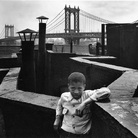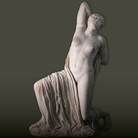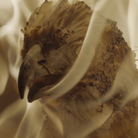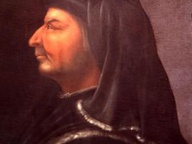Henriette Fortuny. Ritratto di una musa

Dal 19 December 2015 al 1 May 2016
Venezia
Luogo: Museo di Palazzo Fortuny
Indirizzo: San Marco - San Beneto
Orari: 10-18; chiuso martedì
Curatori: Daniela Ferretti, Cristina Da Roit
Prolungata: la mostra è stata prorogata
Costo del biglietto: intero € 12, ridotto e gruppi € 10, scuole € 5. Gratuito portatori di handicap con accompagnatore; guide autorizzate della Provincia di Venezia; interpreti turistici che accompagnino gruppi; accompagnatori (max. 2) di gruppi di ragazzi o studenti; accompagnatori (max. 1) di gruppi di adulti; Partner ordinari MUVE; possessori di The Cultivist card (più tre accompagnatori)
Telefono per informazioni: 848082000
E-Mail info: info@fmcvenezia.it
Sito ufficiale: http://www.fortuny.visitmuve.it
Questa mostra è un omaggio a una donna che con la sua intelligenza e sensibilità ha saputo affiancare, ispirare e sostenere uno degli artisti più raffinati del secolo scorso.
Adèle Henriette Nigrin nasce a Fontainebleau nel 1877 e agli inizi del ‘900, a Parigi, incontra Mariano Fortuny.
Lui è un artista già noto, impegnato nella sperimentazione di un complesso sistema d’illuminazione che sin dalle prime applicazioni rivoluzionerà la scenotecnica teatrale.
Le scarne notizie biografiche non ci raccontano altro, ma certo è che dal 1902, per ben 47 anni, Henriette sarà al fianco di Fortuny, contribuendo in misura determinante al successo delle sue straordinarie creazioni tessili.
A lei si deve infatti l’idea del Delphos, l’abito in finissima seta plissettata icona di uno stile mondialmente riconosciuto e simbolo di un’eleganza senza tempo.
Nella casa laboratorio di Palazzo Pesaro degli Orfei Henriette affianca il marito nella produzione dei pregiati tessuti stampati e delle lampade in seta, coordinando le numerose maestranze che con loro collaborano.
Si fa anche carico dei delicati rapporti con una committenza sempre più numerosa e internazionale, lasciando al Maestro la possibilità di dedicarsi interamente agli studi, alle ricerche, alle sperimentazioni nelle varie discipline artistiche.
Dopo la morte del marito (1949) e ceduta la Società Anonima Fortuny all’amica Elsie McNeill, Henriette dedica il resto della sua vita a ottemperare alle disposizioni testamentarie di Mariano – donando numerose opere a musei italiani e spagnoli – e all’inventario dei beni del palazzo, che alla sua scomparsa affida alla città di Venezia.
La mostra, a cura di Daniela Ferretti e Cristina Da Roit, è il frutto del lavoro di ricerca, riordinamento e manutenzione effettuato nel corso del 2015 sulle collezioni del Museo Fortuny, mediante il quale è stato possibile selezionare – da un corpus di oltre dodicimila originali tra lastre di vetro alla gelatina e pellicole in celluloide – duecento fotografie dell’archivio fotografico Fortuny, che sono state oggetto di un importante intervento conservativo e archivistico.
A questo si è aggiunto il riordinamento e l’informatizzazione della raccolta delle matrici per la stampa su tessuto.
In occasione della mostra, per la prima volta in assoluto saranno poi visibili al pubblico alcuni filmati amatoriali girati da Mariano negli anni Trenta.
Si tratta di materiali filmici di recente ritrovamento, costituiti da pellicole in formato pathè baby e 35 mm, sui quali, grazie al contributo della Maison Vuitton, è stata eseguita un’operazione di restauro tecnico e riversamento in digitale a opera dell’Archivio Nazionale Cinema Impresa di Ivrea e dei laboratori La Camera Ottica e Crea dell’Università degli Studi di Udine.
Catalogo Fondazione Musei Civici di Venezia, a cura di Daniela Ferretti, con testi di Daniela Ferretti, Claudio Franzini e Cristina Da Roit.
SCARICA IL COMUNICATO IN PDF

-
 Dal 2 December 2025 al 19 February 2026
Milano | Centro Culturale di Milano
Dal 2 December 2025 al 19 February 2026
Milano | Centro Culturale di Milano
Walter Rosenblum. Il mondo e la tenerezza
-
 Dal 30 November 2025 al 12 April 2026
Gallarate | Museo MA*GA
Dal 30 November 2025 al 12 April 2026
Gallarate | Museo MA*GA
Kandinsky e l’Italia
-
 Dal 29 November 2025 al 12 April 2026
Roma | Musei Capitolini
Dal 29 November 2025 al 12 April 2026
Roma | Musei Capitolini
La Grecia a Roma
-
 Dal 22 November 2025 al 3 May 2026
Torino | Sale Chiablese dei Musei Reali
Dal 22 November 2025 al 3 May 2026
Torino | Sale Chiablese dei Musei Reali
Orazio Gentileschi. Un pittore in viaggio
-
 Dal 20 November 2025 al 25 January 2026
Firenze | Palazzo Strozzi
Dal 20 November 2025 al 25 January 2026
Firenze | Palazzo Strozzi
Andro Eradze. Bones of Tomorrow
-
 Dal 21 November 2025 al 28 March 2026
Cuneo | Complesso Monumentale di San Francesco
Dal 21 November 2025 al 28 March 2026
Cuneo | Complesso Monumentale di San Francesco
La Galleria Borghese. Da Raffaello a Bernini. Storia di una collezione


